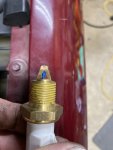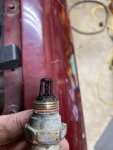corerftech
Active Member
- Joined
- Apr 22, 2021
- Messages
- 208
- Reaction score
- 84
- Points
- 28
- Location
- Memphis, TN
- Vehicle Year
- 1987
- Make / Model
- Ford Ranger
- Transmission
- Automatic
Folks my 1990 Mississippi brutalized truck is just about to hit the road, after many hours of repairs to all major and most minor systems.
Last night I dealt with most all the exhaust leaks, from a butchered flow master knock off install. I found it cheaper (and that’s the point at this time, to install a cherry bomb and a 2.5 inch turn down just before the rear axle. I still have a minor leak at the ball/socket for the header down pipe.
I say all that because every time the truck is started (after being run or recently started) there is a decisive pop or backfire at ignition.
Having spent much time in the fuel system, even yesterday to deal with a sending unit wiper that lost contact with the brass pivot base and gauge went to extra full. I noticed that if the truck sits, it “seems” as though fuel pressure is lost. Prior to a file filter change after a few days of sitting, I tried to bleed pressure off at the Shrader valve and there was zero.
I would expect that an exhaust backfire might come from fuel, excess, that has made its way via an exhaust valve open to the exhaust.
The truck was running very rich. Soot everywhere. Now that the ignition system and sensors are doing their part, only rich (by smell) at cold start.
I have concerns about leaking injectors. No codes anymore. Truck behaves flawless except the backfire. But I think the backfire is indicative of a problem that may worsen.
Given the lack of static pressure in the fuel system shortly after a run, I suppose the regulator could be leaking back to the tank due to failure or….. leaking injectors. Injectors may be the reason for what still could be rich conditions.
Anyone care to through some conjecture at this? Car is bone stock except the newish exhaust remediation.
Lastly , a point for future reference. This is a beater truck that has been hurt but the core of the truck is solid. Dollars invested are not going to pay dividends beyond a certain measure. The exhaust repair was my second exhaust work. Autozone junk thin wall section had to be added to an old thick wall (read:quality) pipe to get the muffler where it belongs. Cheap and less than dirty was the directive. I welded all but the new thin wall to old pipe after the head pipe (under passenger seat). I used a quality 2.5 inch clamp for a seal. Seal has two obvious leaks at tips of the clamp saddle. I was not happy, “junk clamp”???? Blah blah blah. Then I was perusing the net and hit walker muffler website and a guide to clamps and use parameters.
Aha—— you need two clamps per joint, one 90 degrees phase from the first. Walker explains the conditions for each clamp and their pros and cons. I didn’t weld as the down pipe is really more than I am choosing to tackle and access is only doable with a gas torch ala muffler shop. They can do blind welds above the pipe much easier than I can and they do it daily. But a clamp should be fine. For what it’s worth, I learned two clamps out of phase 90 degrees is the proper way to have a leak proof joint that will last forever (not serviceable though) without the need for a band type clamp.
As always, thanks in advance for the ideas on my backfire problem. Literally the last problem I face.
Last night I dealt with most all the exhaust leaks, from a butchered flow master knock off install. I found it cheaper (and that’s the point at this time, to install a cherry bomb and a 2.5 inch turn down just before the rear axle. I still have a minor leak at the ball/socket for the header down pipe.
I say all that because every time the truck is started (after being run or recently started) there is a decisive pop or backfire at ignition.
Having spent much time in the fuel system, even yesterday to deal with a sending unit wiper that lost contact with the brass pivot base and gauge went to extra full. I noticed that if the truck sits, it “seems” as though fuel pressure is lost. Prior to a file filter change after a few days of sitting, I tried to bleed pressure off at the Shrader valve and there was zero.
I would expect that an exhaust backfire might come from fuel, excess, that has made its way via an exhaust valve open to the exhaust.
The truck was running very rich. Soot everywhere. Now that the ignition system and sensors are doing their part, only rich (by smell) at cold start.
I have concerns about leaking injectors. No codes anymore. Truck behaves flawless except the backfire. But I think the backfire is indicative of a problem that may worsen.
Given the lack of static pressure in the fuel system shortly after a run, I suppose the regulator could be leaking back to the tank due to failure or….. leaking injectors. Injectors may be the reason for what still could be rich conditions.
Anyone care to through some conjecture at this? Car is bone stock except the newish exhaust remediation.
Lastly , a point for future reference. This is a beater truck that has been hurt but the core of the truck is solid. Dollars invested are not going to pay dividends beyond a certain measure. The exhaust repair was my second exhaust work. Autozone junk thin wall section had to be added to an old thick wall (read:quality) pipe to get the muffler where it belongs. Cheap and less than dirty was the directive. I welded all but the new thin wall to old pipe after the head pipe (under passenger seat). I used a quality 2.5 inch clamp for a seal. Seal has two obvious leaks at tips of the clamp saddle. I was not happy, “junk clamp”???? Blah blah blah. Then I was perusing the net and hit walker muffler website and a guide to clamps and use parameters.
Aha—— you need two clamps per joint, one 90 degrees phase from the first. Walker explains the conditions for each clamp and their pros and cons. I didn’t weld as the down pipe is really more than I am choosing to tackle and access is only doable with a gas torch ala muffler shop. They can do blind welds above the pipe much easier than I can and they do it daily. But a clamp should be fine. For what it’s worth, I learned two clamps out of phase 90 degrees is the proper way to have a leak proof joint that will last forever (not serviceable though) without the need for a band type clamp.
As always, thanks in advance for the ideas on my backfire problem. Literally the last problem I face.


















